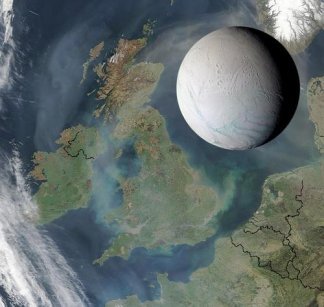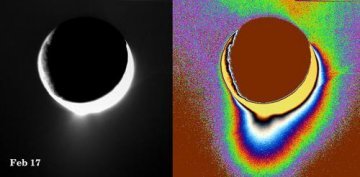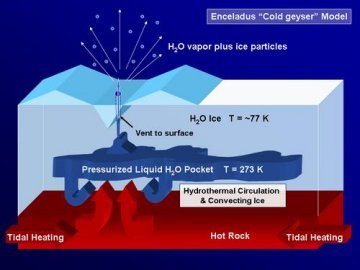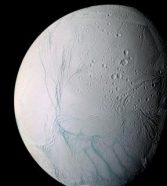Saturn’s Strangely Warm Moon
Saturn's mysterious moon Enceladus may have liquid water close enough to its surface to produce giant geysers.
By Emily Sohn
Weird things are happening on Saturn’s moon Enceladus.
The small moon, only 505 kilometers (314 miles) wide, was thought to be cold and icy. But new findings suggest that Enceladus (pronounced en-SELL-ah-dus) is oozing heat. And there might be pools of liquid water just below its surface.
 |
|
Only 505 kilometers across, Saturn’s moon Enceladus is small enough to fit within the length of the United Kingdom, as illustrated here. The intriguing moon also could fit comfortably within the states of Arizona or Colorado.
|
| NASA/JPL/Space Science Institute |
That’s a surprise because Saturn orbits, on average, about 1.3 billion kilometers (more than 800 million miles) from the sun. “You expect everything to be cold and frozen” out there, says Andrew Ingersoll. He’s a planetary scientist at the California Institute of Technology in Pasadena.
Instead, Enceladus appears to be one of the few planets or moons in the solar system that generates detectable heat of its own.
Startling data
The evidence comes from the Cassini spacecraft, which has been orbiting Saturn since July 2004 (see “Ringing Saturn“). When Cassini passed close to Enceladus in 2005, it sent data from a dozen scientific instruments to teams of scientists across the United States.
Soon after the data came in, the teams shared their discoveries during a phone conference. Each group was surprised by what it saw at the moon’s southern tip.
“It was one of the most exciting phone calls I can remember,” says planetary scientist John Spencer of the Southwest Research Institute in Boulder, Colo. “Everyone kept chiming in, ‘Hey, we see something strange going on at the south pole as well!'”
An instrument for measuring magnetism detected unusual warping in the magnetic field around the moon’s south pole. A detector for measuring infrared radiation (which is associated with heat) sensed a hot spot in the same polar area. Another instrument saw glassy ice there, but nowhere else, on the moon. Cameras revealed large cracks on the surface. Other instruments unveiled a cloud of gas, which contained tiny grains of water ice and other ingredients, over the pole.
The observations fit together like the pieces of a puzzle. “There must be gas and dust coming out of the south pole,” Spencer says.
 |
|
Plumes of icy material spew from the southern polar region of Enceladus. The color-coded version of the image (right) reveals that the icy fountain extends hundreds of miles into space.
|
| NASA/JPL/Space Science Institute |
Indeed, later images showed a geyser of ice crystals and other material shooting hundreds of miles into space (see “A Moon’s Icy Spray“). That’s as high as Enceladus is wide.
“The most obvious way to produce geysers is to have boiling liquid [inside the moon],” Ingersoll says. When liquid water hits the vacuum of space, it freezes immediately to form tiny ice particles.
Oozing heat
The only explanation for these unexpected findings is that Enceladus somehow supplies its own heat, Ingersoll says. “Sunlight could not possibly produce temperatures like that in the outer solar system.”
 |
|
Pushes and pulls from Saturn could heat up rock inside Enceladus. The hot rock could, in turn, heat pressurized water (H2O) just below the moon’s surface. Boiling water and vapor could then escape through cracks in the moon’s surface, producing a geyser of ice particles. |
| NASA/JPL/Space Science Institute |
Scientists are still trying to figure out how Enceladus gets its warm glow. The leading theory is that the pulls and pushes from Saturn and its other moons heat rock inside Enceladus. All the little tugs add up to a big effect, and the shifting rock generates heat.
“It’s like giving a child a little push on a swing,” Spencer says. “Every time he goes past, if you push just right, the little pushes can build up into quite a big swing.”
Having a detectable internal heat source makes Enceladus an especially rare place. Earth, Jupiter’s moon Io, and perhaps Neptune’s moon Triton are the only other bodies in the solar system known to generate detectable heat. Both Earth and Io have volcanoes that release molten material and vapor. On Enceladus, heat seems to escape from deep cracks in the southern polar region.
 |
|
The southern polar region of Enceladus has long, deep cracks. The temperature (measured in kelvins) is higher directly over such cracks. The number above each colored box is the average temperature of the area within the box. The temperature inside the narrow crack itself (cutting across middle box) may be as high as 145 kelvins (about –200 degrees Fahrenheit or –130 degrees Celsius). |
| NASA/JPL/Space Science Institute |
The scientists estimate that there could be boiling water as close as 40 meters (130 feet) beneath Enceladus’ surface. That’s especially exciting, Ingersoll says, because finding liquid water is a first step toward possible evidence of life on a planet or moon.
New mysteries
The recent observations have raised a slew of new mysteries.
For example, scientists had assumed that Enceladus’ geysers would contain ammonia, a common chemical that softens ice and allows it to flow like lava. The presence of ammonia would explain why parts of the moon’s surface appear smooth instead of pockmarked by craters.
 | ||
|
| ||
| NASA/JPL/Space Science Institute |
Cassini’s instruments, however, haven’t detected any ammonia. But in addition to water, the plumes of material spewing from Enceladus do contain nitrogen, along with methane, carbon dioxide, and other carbon-containing molecules.
Why the moon’s hot spot is in the southern polar region is also perplexing. On Earth, the poles are some of the coldest places on the planet.
Cassini will pass by Enceladus again in 2008. On that trip, the spacecraft will snap detailed photos of various surface features and maybe even peer inside the moon’s canyons.
In the meantime, scientists have piles of data to analyze. For such a small place, Enceladus has plenty of lessons to offer. “You don’t have to be big to be interesting,” Spencer says. “Tiny little places like Enceladus can have a lot of exotic stuff going on.”
In space science, nothing is too small to turn up the heat.
Going Deeper:







